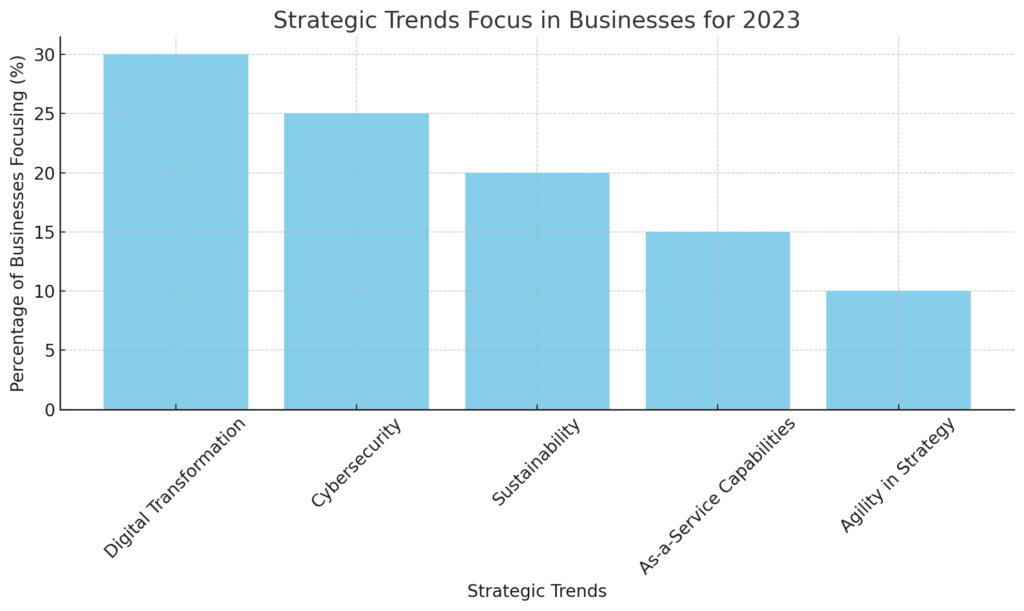In the intricate world of business, the path from a visionary idea to a tangible success story is often paved with strategic planning. This vital process serves as the backbone of organizational success, transforming lofty visions into achievable milestones. Strategic planning, with its focus on long-term goals and actionable steps, is more than just a business practice; it’s a roadmap to actualizing potential and navigating the complexities of today’s ever-evolving market landscapes.
The role of strategic planning in modern business cannot be overstated. It’s the guiding force that allows businesses to chart a course through the unpredictable waters of market trends, competitive pressures, and evolving customer needs. In this article, we delve into how strategic planning acts as a critical tool for businesses, enabling them to align their resources, forecast future challenges, and capitalize on emerging opportunities.
Our exploration will dive into the intricate process of strategic planning, dissecting its key components from vision setting to strategy formulation. We aim to illuminate the importance of each element in the broader context of business success. By the end of this discussion, readers will have a comprehensive understanding of how strategic planning empowers businesses to convert their abstract visions into concrete realities, ultimately driving growth and sustainability in a competitive world.
The Fundamentals of Strategic Planning in Business
Strategic planning stands as a cornerstone in the realm of business, instrumental in turning abstract visions into achievable objectives. This process, quintessential for businesses across scales and industries, is a meticulous blend of foresight, analysis, and structured action. It begins with the articulation of a clear and compelling vision – the overarching goal that defines the ultimate destination for the business. This vision serves as a guiding beacon, aligning all strategic decisions and actions.
Transitioning from this high-level vision, strategic planning then demands the identification of specific, measurable goals. These goals are not just arbitrary targets; they are carefully crafted to be SMART – Specific, Measurable, Achievable, Relevant, and Time-bound. This phase is critical as it translates the grand vision into tangible milestones, creating a structured pathway towards achievement.
The crux of strategic planning lies in the formulation of strategies – the actual roadmap of how the vision and goals will be achieved. This stage is an intricate exercise in understanding and maneuvering through the business landscape. It necessitates a thorough analysis of internal and external environments, including market dynamics, competitive scenarios, and the company’s strengths and weaknesses. Here, strategies are developed to capitalize on opportunities and mitigate risks, ensuring that the business is not only geared towards achieving its goals but is also resilient and adaptive to market changes.
Strategic planning is about creating a coherent narrative for the business’s future. It’s a comprehensive process that binds the company’s aspirations with realistic and well-thought-out plans, ensuring a focused and strategic march towards success and sustainability. Understanding these fundamental aspects of strategic planning is pivotal for any business aiming to convert their vision into a successful reality.
Crafting a Successful Strategic Plan
Developing an effective strategic plan is a critical process for any business aiming to transform its vision into reality. It’s a journey that begins with a clear articulation of the business’s vision, which serves as the foundation for all future endeavors. This vision should be both aspirational and achievable, guiding the overall direction of the company. The next pivotal step is involving your team. Strategic planning should be a collaborative effort, incorporating insights and perspectives from various departments within the organization. This inclusion not only enriches the plan but also ensures buy-in from those involved in its execution.
A thorough market analysis is indispensable. This involves a deep dive into the industry landscape, understanding competitors, and staying abreast of market trends. The insights gained from this analysis provide a solid base for strategic decision-making, ensuring that the plan is grounded in reality and poised to capitalize on market opportunities. Following the analysis, the focus shifts to setting measurable goals. These goals should be aligned with the overarching vision and broken down into specific, measurable, achievable, relevant, and time-bound (SMART) objectives. This clarity in goal-setting is crucial for tracking progress and maintaining focus.
With clear goals in hand, the next phase is developing strategies and action plans for each objective. This includes detailing the necessary resources, assigning responsibilities, and setting deadlines. It’s about translating goals into actionable steps that the team can follow. The implementation of the plan is where these strategies come to life. It’s crucial that every team member understands their role and the importance of their contributions to the broader vision.
Lastly, the strategic plan is not set in stone. It requires continuous monitoring and adaptation. The business environment is dynamic, and the plan should be flexible enough to accommodate changes and overcome unforeseen challenges. Regularly reviewing and adjusting the plan ensures that the business remains on track and aligned with its goals.
Crafting a successful strategic plan is a meticulous and dynamic process. It requires clear vision articulation, collaborative effort, thorough market analysis, SMART goal setting, and adaptive implementation. This strategic blueprint is fundamental for guiding businesses through the complexities of the market, turning their visions into tangible successes.
2023’s Strategic Imperatives for Business: Digital Dominance and Sustainable Futures

The bar chart succinctly captures the primary strategic trends that businesses are focusing on in 2023. The most significant emphasis is on Digital Transformation, reflecting a widespread recognition of its critical role in adapting to the rapidly changing business landscape. Cybersecurity follows closely, underscoring the increasing importance of digital security in an era of heightened online threats.
Sustainability ranks third, highlighting the growing trend of integrating environmental and social responsibility into business operations. This shift indicates a broader move towards ethical business practices and reflects a recognition of the importance of sustainable development in long-term business success.
As-a-Service Capabilities and Agility in Strategy also feature prominently, pointing to the need for flexible and scalable business models. The adoption of as-a-service models suggests a move towards more cost-effective, efficient, and adaptable business operations. Meanwhile, agility in strategy underscores the importance of being able to rapidly respond to market changes and emerging trends.
This chart not only provides a visual representation of the current strategic priorities but also serves as a guide for businesses aiming to align with these key trends. Embracing digital transformation, prioritizing cybersecurity, committing to sustainability, adopting flexible service models, and maintaining strategic agility are no longer just options but necessities for businesses seeking to thrive in 2023 and beyond.
These strategic imperatives are crucial for navigating the complexities of the current economic and geopolitical landscape. They offer a roadmap for businesses to stay competitive, resilient, and aligned with evolving market expectations and societal values. As we move further into 2023, these trends are likely to shape the business world significantly, driving innovation, growth, and sustainable development.
Top 5 Benefits of Strategic Planning in Business
Strategic planning is not just a business ritual; it’s a catalyst for transformation and growth. Here are the top five benefits of strategic planning in business:
- Enhanced Focus and Direction: Strategic planning provides a clear direction for your business, aligning all activities with your overarching goals. It helps maintain focus on long-term objectives, even while navigating short-term challenges.
- Improved Resource Management: It enables efficient allocation of resources by identifying key areas that contribute most to your goals. This focus on resource optimization ensures that every dollar and every hour is spent where it matters most.
- Increased Market Responsiveness and Adaptability: With a well-crafted strategic plan, businesses can anticipate market changes and adapt quickly. This responsiveness is crucial in maintaining a competitive edge in today’s fast-paced market environment.
- Better Risk Management and Contingency Planning: Strategic planning involves identifying potential risks and developing contingency plans. This proactive approach to risk management can save your business from potential crises and unexpected challenges.
- Long-term Business Growth and Sustainability: By setting a clear path for growth and continuously adapting to market changes, strategic planning lays the foundation for long-term sustainability and success. It turns short-term gains into a trajectory for enduring success.
Strategic planning is an indispensable tool in the arsenal of any business. It’s about making informed decisions today that will shape the future of your business. Whether you’re a start-up or a well-established enterprise, the benefits of strategic planning are universal, providing clarity, efficiency, adaptability, and long-term growth. By investing time and resources into strategic planning, businesses position themselves not just to survive but to thrive in the ever-changing business landscape. This proactive approach to business management empowers organizations to turn their visions into reality, guiding them through market uncertainties and towards a prosperous future. Remember, the success of any business hinges not just on the strength of its vision but on the effectiveness of its strategic plan.
Future Trends in Strategic Planning
In the realm of strategic planning, the constant evolution of business landscapes is prompting a significant transformation in approaches and methodologies. Business leaders and strategists are pinpointing several emerging trends that are reshaping the way strategic planning is conducted in contemporary business environments.
A dominant trend is the increasing integration of advanced technologies, such as Artificial Intelligence (AI) and data analytics, into the strategic planning process. These technologies are revolutionizing the way businesses analyze data, forecast trends, and make informed decisions. AI, in particular, is enabling businesses to simulate various market scenarios and predict outcomes, allowing for more accurate and effective strategies. This technological integration is not just about data processing capabilities; it’s about gaining deeper insights and creating more sophisticated, forward-thinking strategies.
Another significant trend is the growing emphasis on agility and flexibility in strategic planning. The rapid pace of change in today’s business world demands strategies that are not only robust but also adaptable. Businesses are recognizing the need for strategic plans that can be quickly and effectively modified in response to changing market conditions, technological advancements, and competitor actions. This shift towards agile planning enables businesses to remain competitive and responsive in a dynamic market environment.
Sustainability and social responsibility are also becoming integral components of strategic planning. This trend reflects a broader societal shift towards more ethical business practices and a recognition of the importance of aligning business objectives with environmental and societal concerns. Companies are increasingly viewing sustainability as a key driver of innovation and long-term success, rather than as a mere compliance requirement.
Furthermore, there is a move towards more collaborative and inclusive strategic planning processes. This involves engaging a broader range of stakeholders, including employees, customers, and even the wider community, in the planning process. Such inclusivity ensures a diversity of perspectives and ideas, fostering more creative and effective strategic plans.
These emerging trends in strategic planning highlight a paradigm shift from traditional, rigid planning to more dynamic, technologically integrated, and socially responsible approaches. As businesses continue to navigate an increasingly complex and fast-paced global environment, these trends are likely to become even more pronounced, shaping the future of strategic planning in the business world.
Some FAQs Answered On The Relevant Topic
How do you ensure that a strategic plan remains relevant in a rapidly changing business environment?
The key is to build flexibility into the strategic plan. Regularly review and update your plan to reflect changing market conditions, technological advancements, and emerging trends. Incorporate a system for monitoring key performance indicators (KPIs) and market signals to enable timely adjustments.
What are some common challenges in implementing a strategic plan?
Common challenges include aligning the plan with the company’s overall vision, ensuring buy-in from all stakeholders, managing resource constraints, and effectively communicating the plan throughout the organization. Overcoming these challenges requires clear communication, stakeholder engagement, and efficient resource management.
How can small businesses develop effective strategic plans without extensive resources?
Small businesses can focus on their core strengths and market niche. Use lean strategic planning methods, focus on a few critical objectives, and leverage digital tools for market analysis and planning. Outsourcing or consulting can also be a cost-effective way to access expert advice.
In Conclusion
Strategic planning is an indispensable tool in the business world, acting as the bridge between visionary ideas and tangible success. It equips businesses to navigate the complexities of today’s market, adapt to rapid changes, and seize emerging opportunities. The incorporation of advanced technologies like AI, a focus on agility and adaptability, and a commitment to sustainability and social responsibility are shaping the future of strategic planning. As businesses continue to operate in an increasingly competitive and dynamic environment, the value of a well-crafted strategic plan cannot be overstated. It’s essential for businesses to invest in robust strategic planning, embracing both traditional best practices and emerging trends, to ensure sustained growth and long-term success.

Thomas J. Powell is a distinguished Senior Advisor at Brehon Strategies and a recognized figure in the realm of entrepreneurship and private equity. His journey in the financial services and banking sector, starting in 1988 in Silicon Valley, spans more than 35 years and is marked by profound industry expertise. Powell’s dual citizenship in the European Union and the United States empowers him to adeptly steer through international business landscapes. Currently studying for his Doctor of Law and Policy at Northeastern University, his research is centered on addressing the shortage of middle-income workforce housing in rural resort areas. Alongside his professional pursuits, he remains committed to community enrichment, illustrated by his 45-year association with the Boys and Girls Clubs of America. Follow Thomas J Powell on Twitter, Linkedin etc.

